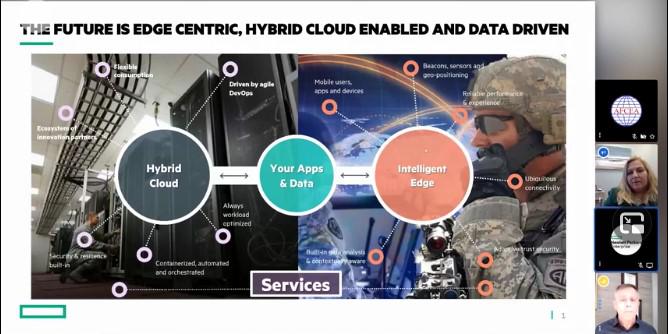Government Must Pivot to the Intelligent Edge with Private Sector
The future enterprise will be edge-centric, cloud enabled and data driven, said Bill Burnham, CTO, U.S. Public Sector Business Unit, Hewlett Packard Enterprise.
He shared his ideas during an AFCEA online event titled “The Edge Is Where the Action Is!”
Burnham spent 30 years working in the federal space, including seven years as the chief technology officer for the U.S. Special Operations Command. There, he was responsible for the modernization of the global information and services networks supporting 70,000 special operations users. He provided both an industry and government perspective on data and the future of information technology (IT) during the virtual discussion.
“The difference I see [between public and private sector] when you start talking about solutions and solution monitoring is in the private sector we have big companies who come to us and metaphorically they say, ‘I want a German chocolate cake,’” he said. “They order off the menu of solutions.”
His experience in government was much different. “We [the government] find ourselves competing for the ingredients in the pantry. We put out bids for pieces and parts and ingredients that would make the German chocolate cake to get the most bang for our buck,” Burnham explained.
“But what ends up happening a lot of times is it’s a federal government pantry full of pieces of IT that weren’t really meant to go together,” he adds. “You really can’t make a good German chocolate cake out of it, and you better have a chef on staff that knows how to cook it,” emphasized Burnham.
He adds that the government has started to get there with managed services and, requests for information (RFIs), but a lot of government agencies aren’t funded to do as-a-service. “They’re still procurement based and compete in silos. I think we’ve got some work to do there,” Burnham said.
The private sector has pivoted its investment dollars to enabling the intelligent edge, creating capabilities beyond what the Defense Department has asked for, he said. Terabytes of data are being generated from enterprise digital edges such as vehicles, planes, facilities and infrastructure. The manipulation of these data sources at the edge can enable insights and intelligence to improve operations and decision-making, added Burnham.
Ingesting and analyzing massive amounts of data requires a large amount of compute capacity.
“A data center moving forward is as much a data center as this is a phone,” he said, holding up his iPhone. “We still call this a phone, but particularly if you’re under 30, 5 percent of your time may be on the phone app. It’s now a pocket computer but we still call it a phone because of its history,” stated Burnham.
“Data does not reside in data centers anymore. Data is now out where we sense it and that’s where the private sector is moving,” he continued. “We’re seeing a big focus on processing data where it’s generated, also known as edge processing,”
Burnham emphasized that industry is as focused or more focused on the Cybersecurity Maturity Model Certification (CMMC) framework and cybersecurity. “[Industry] demands resiliency at the cybersecurity level. They demand pedigree and understanding where pieces and parts come from,” he said.
He explained that the firmware attacks in 2017 forced HPE to build its own baseboard management controller (BMC) processor. Essentially it’s the very first chip on the motherboard that gets power.
“It generally is a pretty dumb chip, it doesn’t do much for you, but it does have firmware,” said Burnham. “And there’s nothing below the BMC chip that could identify it’s being owned by an adversary.”
Once it became an attack vector, “[HPE] financial customers forced our hand because they could not lose control of their infrastructure even for an hour, let alone a day due to a firmware attack, so we designed our own. That’s baked into everything we’re doing going forward,” he added.
Hear more from Bill Burnham and find out what he has to say about cloud native computing by watching the full online event on-demand here.





Comments